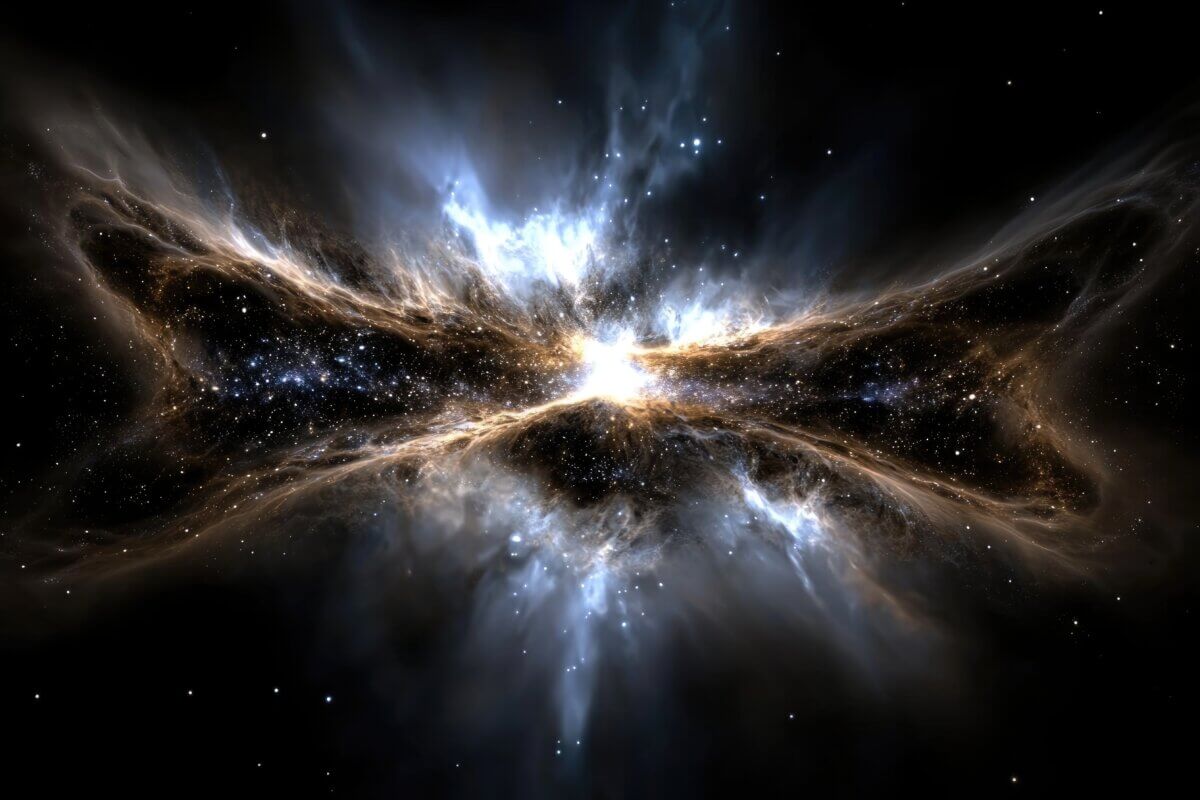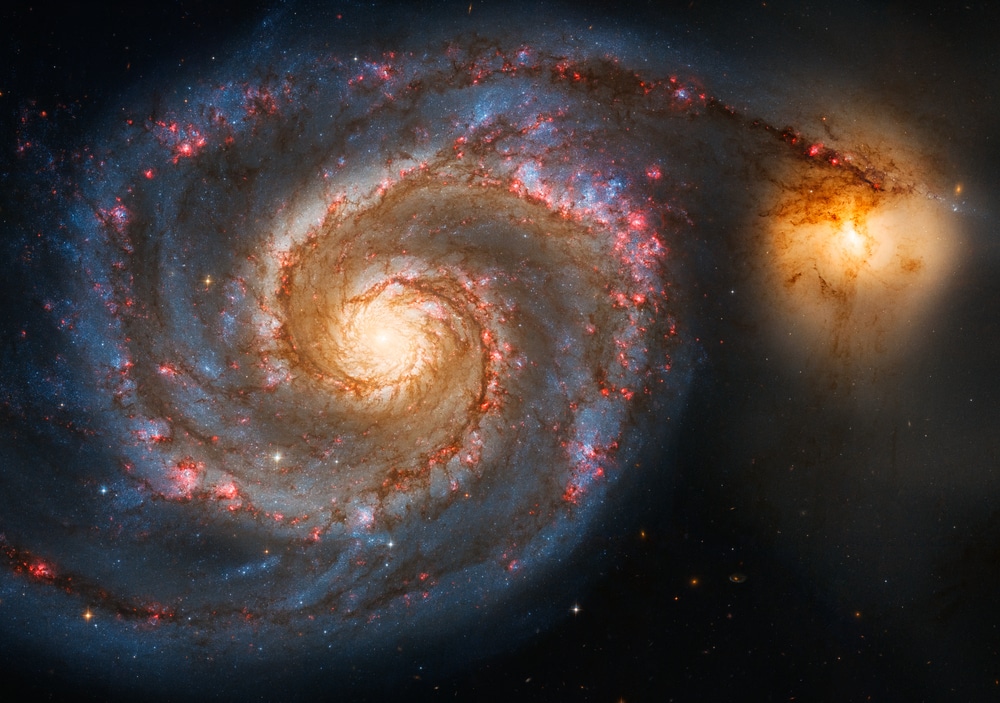
Primordial creation: The universe begins with the Big Bang, an extraordinary moment of immense energy, igniting formation of everything in existence. (© Alla - stock.adobe.com)
In a nutshell
- Scientists propose that the entire universe might be spinning very slowly (0.002 rotations per billion years), which could explain why different methods of measuring cosmic expansion give conflicting results.
- This rotation rate is curiously close to the maximum possible rotation that would avoid creating problematic “time travel” pathways in physics.
- If confirmed, this theory would solve the “Hubble tension” – one of the biggest mysteries in modern cosmology – without contradicting our understanding of physics.
The Hubble Puzzle: A Cosmic Disagreement
HONOLULU — Scientists think our cosmos might be turning like a merry-go-round, potentially fixing one of astronomy’s biggest headaches. Recent research from Hungarian and American physicists points to cosmic rotation as an explanation for why scientists keep getting different numbers when measuring how fast the universe is expanding.
For years, astronomers have been puzzled by what’s called the “Hubble tension” – a persistent disagreement between different ways of measuring cosmic expansion. When astronomers look at nearby exploding stars, they get one answer. When they examine the oldest light in the universe (from shortly after the Big Bang), they get a noticeably different answer. This difference has grown so statistically significant that it’s almost impossible to chalk it up to measurement error.
“If not due to unknown systematics, the Hubble Puzzle suggests a lack of understanding of the universe’s expansion history despite the otherwise spectacular success of the theory,” the researchers wrote in their paper, published in Monthly Notices of the Royal Astronomical Society.
A Rotating Universe: Not as Strange as It Sounds
The fix proposed by these scientists? The entire universe might be rotating at an extremely slow rate.
It may sound far-fetched at first, but look around – rotation appears everywhere in nature. Planets spin, stars rotate, galaxies whirl, and black holes typically spin near their maximum possible speeds. The researchers wondered if this pattern extends to the universe itself.
The team created mathematical models showing that if the cosmos rotates at a specific, very slow speed, it would create exactly the pattern of measurements that astronomers currently observe. When measured locally using supernovae (exploding stars), the universe would appear to expand faster than when measured across the entire cosmos.
How slow is this proposed rotation? About 0.002 rotations per billion years – meaning the universe would need roughly 500 billion years to complete just one turn. For comparison, our Milky Way galaxy makes a full rotation every 250 million years.

Solving the Mystery Without Breaking Physics
What’s particularly interesting about this theory is that the calculated rotation rate sits right at the theoretical boundary for how fast the universe could possibly turn without creating pathways that could permit time travel – something most physicists consider physically impossible.
When astronomers measure the universe’s expansion using nearby supernovae, they consistently get a value around 73 kilometers per second per megaparsec (a unit of astronomical distance). But when they calculate it based on the cosmic microwave background (the afterglow of the Big Bang), they get about 67.4. This 8% difference represents a major problem for our understanding of the cosmos.
The rotating universe model predicts this exact pattern – near us, the expansion would measure higher, while globally, it would match the lower value from cosmic background radiation.
What Comes Next?
The approach builds on earlier work by mathematician Kurt Gödel, who first proposed a rotating universe model in 1947. This new version avoids the problems of Gödel’s original concept while preserving the key insight that cosmic rotation could significantly affect how we perceive the universe’s expansion.
The researchers acknowledge that more work needs to be done before their spinning universe theory can challenge mainstream cosmology. They must show that their model aligns with other well-established astronomical observations.
If confirmed by additional studies, this spinning universe model would transform our understanding of cosmic evolution, explaining one of the most persistent puzzles in modern astronomy without contradicting our current understanding of physics.
Paper Summary
Methodology
The researchers tackled the Hubble tension problem using fluid dynamics. They created a “dark fluid” model treating the universe’s contents as a non-viscous, self-gravitating fluid described by the Euler-Poisson system of equations. They solved these equations using a self-similar approach that incorporates time-dependent scaling. To model rotation, they added a rotational term to the equations and calculated how this would affect expansion over time. The team used numerical methods to evolve their equations from the cosmic microwave background era (about 380,000 years after the Big Bang) to today, comparing results from different initial rotation rates.
Results
The study found that a universe with an angular rotation velocity of approximately 0.002 rotations per billion years would produce Hubble constant measurements matching observations. Their calculations showed that this rotation would create a discrepancy between local measurements (using supernovae) and global measurements (using the cosmic microwave background) that matches the observed 5-sigma tension between HSNe = 73.04 ± 1.07 km/s/Mpc and HCMB = 67.4 ± 0.5 km/s/Mpc. This rotation rate is very close to the maximum rotation that would avoid creating closed time-like loops where tangential velocity exceeds light speed at the cosmic horizon.
Limitations
The researchers acknowledge several limitations. They used a Newtonian approximation rather than a full general relativistic treatment, which they plan to address in future work. The paper focused only on explaining the Hubble constant discrepancy and didn’t yet show that their rotating model is consistent with other cosmological observations. The authors note that further work is needed to test “the rotating model against the entire intertwined network of the concordance model observations,” including confirmation through rotating cosmological simulations.
Funding
The research received support from the Hungarian National Research, Development and Innovation Office under contract numbers OTKA K135515, 2021-4.1.2-NEMZ_KI-2024-00031, and 2024-1.2.5-TET-2024-00022. Additional support came from the Wigner Scientific Computing Laboratory and NASA grants N4-ADAP24-0021 and 24-ADAP24-0074. István Szapudi received support from the MTA-CSFK Lendület “Momentum” Large-Scale Structure Research Group at Konkoly Observatory funded by the Hungarian Academy of Sciences.
Publication Information
The paper “Can rotation solve the Hubble Puzzle?” was published in Monthly Notices of the Royal Astronomical Society (MNRAS 538, 3038–3041) on March 21, 2025. Authors include Balázs Endre Szigeti, István Szapudi, Imre Ferenc Barna, and Gergely Gábor Barnaföldi from the Institute of Physics at Eötvös Loránd University in Hungary, the HUN-REN Wigner Research Centre for Physics in Budapest, and the Institute for Astronomy at the University of Hawaii.







